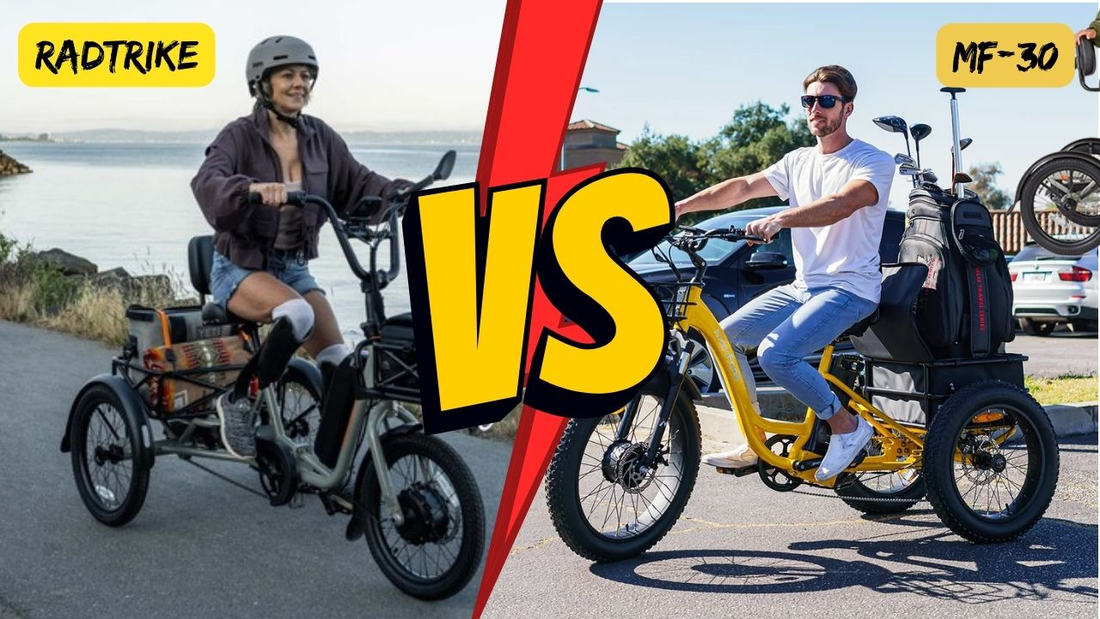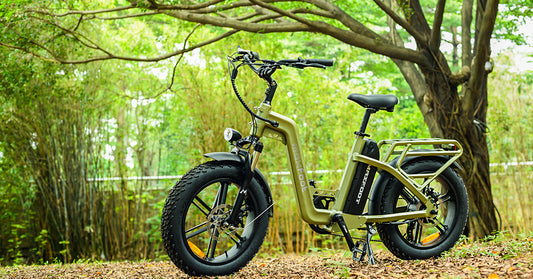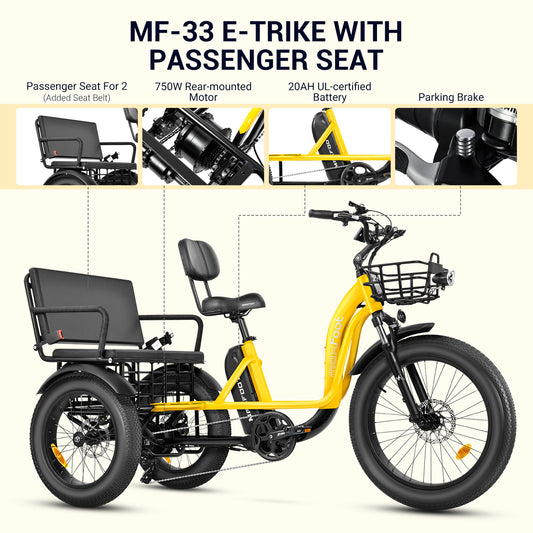When exploring the world of electric trikes, stability, and freedom are key components in selecting the perfect three-wheeled companion. Whether you desire a reliable vehicle to roam freely with your goods or are considering starting a business with a tricycle as your partner, the choices can be overwhelming.
Two powerful contenders in this sector are the Maxfoot MF-30 and RadPower RadTrike. Both are renowned for their unique features and capabilities, but the question remains: which one should you choose?
In this comparison article, we will dissect the features of each bike, and provide a comprehensive overview to aid you in making an informed decision.
Maxfoot MF-30 vs. RadPower RadTrike: A Quick Comparison
MF-30 is Maxfoot’s best and only three-wheeled electric vehicle. It comes with a 750W which can easily carry 350 lbs. of weight and 100 lbs. extra weight. Its exceptional 65-mile range and shock-resistant suspension give you the most out of a ride.
RadTrike is also the only three-legged child in the Rad Power family. It comes with a 750W motor which can propel the bike to 14 mph. The trike is perfectly priced but all the essential add-ons come at an additional price.
|
Features |
Maxfoot MF-30 |
Rad Trike |
|
Price |
$2,399 |
$1,899 |
|
Motor Power |
750W |
750W |
|
Battery |
Samsung 48 Volt 17.5 Ah |
48V/10 Ah |
|
Charging Time |
6 – 7 hrs. |
3 – 7 hrs. |
|
Maximum Range |
50-65 with PAS 1 |
55 miles |
|
Top Speed |
20 mph |
14 mph |
|
Suspension |
50 mm front travel |
Rigid steel fork |
|
Tires |
Front (24″ x 4 ″), Rear (20″ x 4″) |
(18″ x 2.25″) |
|
Gross Weight |
100 lbs. |
82 lbs. |
|
Max. Supported Weight |
350 lbs. + 100 (Rear) lbs. |
315 + 100 (Rear) lbs. |
Maxfoot MF-30 vs. RadTrike: Frame Design and Comfort
In the electric trike market, frame design and comfort are crucial, and both Maxfoot MF-30 and RadTrike offer a step-through design. This design is ideal for easy mounting and dismounting.
The MF-30 boasts a frame made from Aluminum alloy, a material known for its strength and lightweight properties. On the other hand, the RadTrike features a frame constructed from Chromoly, renowned for its durability and resilience. Between the two, Aluminum alloy is generally considered superior due to its lightweight nature and resistance to corrosion.
The MF-30 has a slightly bulkier build due to a heavier battery and wide tries. This added bulk contributes to the stability of the bike. This makes it a reliable choice for those looking to carry goods or start a business. However, Radtrike does have a foldable handlebar which makes it easy to carry around in a car.
Maxfoot MF-30 supports a maximum weight of 450 lbs., including a 100 lbs. at the rear. In contrast, the RadTrike can support up to 315 lbs., with an additional 100 lbs. at the rear.
For those prioritizing comfort, both trikes come equipped with adjustable backrest saddles that allow riders to find their optimal seating position for a more enjoyable ride.
Maxfoot MF-30 vs. RadTrike: Power and Performance
In the realm of power and performance, the difference is little. Both trikes are equipped with a 750W motor, which offers ample power to navigate various terrains.
However, when it comes to top speed, the MF-30 takes the lead with a maximum speed of 20 mph. So, this trike’s riders can reach their destinations more swiftly. In contrast, the RadTrike has a top speed of 14 mph, which is sufficient for most uses but may fall short for those seeking a faster ride.
Maxfoot MF-30 vs. RadTrike: Battery and Range
The battery is another pivotal component of the electric trike as it influences the range of the trike; it dictates how far one can travel on a single charge.
Maxfoot MF-30 is equipped with a Samsung 48 Volt 17.5 Ah battery, a robust option that enables an impressive range of 50-65 miles with PAS 1. This substantial range makes the MF-30 a suitable companion for longer journeys.
On the other side, the RadTrike comes with a 48V 10 Ah battery. While this battery is efficient, it offers a slightly lesser range of up to 55 miles. This range is still considerable and meets the needs of most users who need a trike to run small errands.
Maxfoot MF-30 vs. RadTrike: Tires and Suspension
Starting with suspension, the MF-30 is equipped with a 50 mm front travel hydraulic suspension. This feature is pivotal for absorbing shocks and impacts, particularly when traversing uneven terrains.
In contrast, the RadTrike features a rigid steel fork. Although this design is durable and can withstand substantial wear and tear, it may not offer the same level of comfort and shock absorption as a hydraulic suspension.
Moving on to tires, the MF-30 sports larger and wider tires, with the front tire measuring 24" x 4" and the rear tires measuring 20" x 4". These larger, wider tires provide enhanced stability and traction, making the MF-30 well-suited for a variety of terrains and conditions.
The RadTrike is fitted with smaller, narrower 18" x 2.25" tires. While these tires are efficient and can navigate smoothly on well-paved surfaces, they might not offer the same level of stability and versatility as the tires on the MF-30.
Maxfoot MF-30 vs. RadTrike: Add-Ons
RadTrike has a lower price point, but it does not include any additional accessories; items like the rear rack have to be ordered separately. This adds to the overall cost and could be a point of consideration for buyers looking for value-added features included in the initial purchase.
Conversely, the Maxfoot MF-30 offers a range of complimentary accessories that enhance the riding experience. It features an LCD with a USB port, allowing riders to charge their devices on the go.
Additionally, MF-30 comes with multiple free accessories including a mobile holder, back storage bag, side mirrors, and bike fenders. These included add-ons add convenience and save the rider from any additional expenses post-purchase.
Maxfoot MF-30 vs. RadTrike: Which One Should You Choose
Although Maxfoot MF-30 has a higher initial cost compared to the RadTrike, it justifies its price point by offering multiple features and add-ons that a rider might need for a comfortable and convenient ride. The comprehensive package provided by the MF-30, coupled with superior suspension, larger tires, and extended range, make it a value-packed option for prospective buyers.
The RadTrike, with its lower price and durable build, remains a viable option for those on a budget and those who prefer to customize their trike with add-ons of their choosing.




